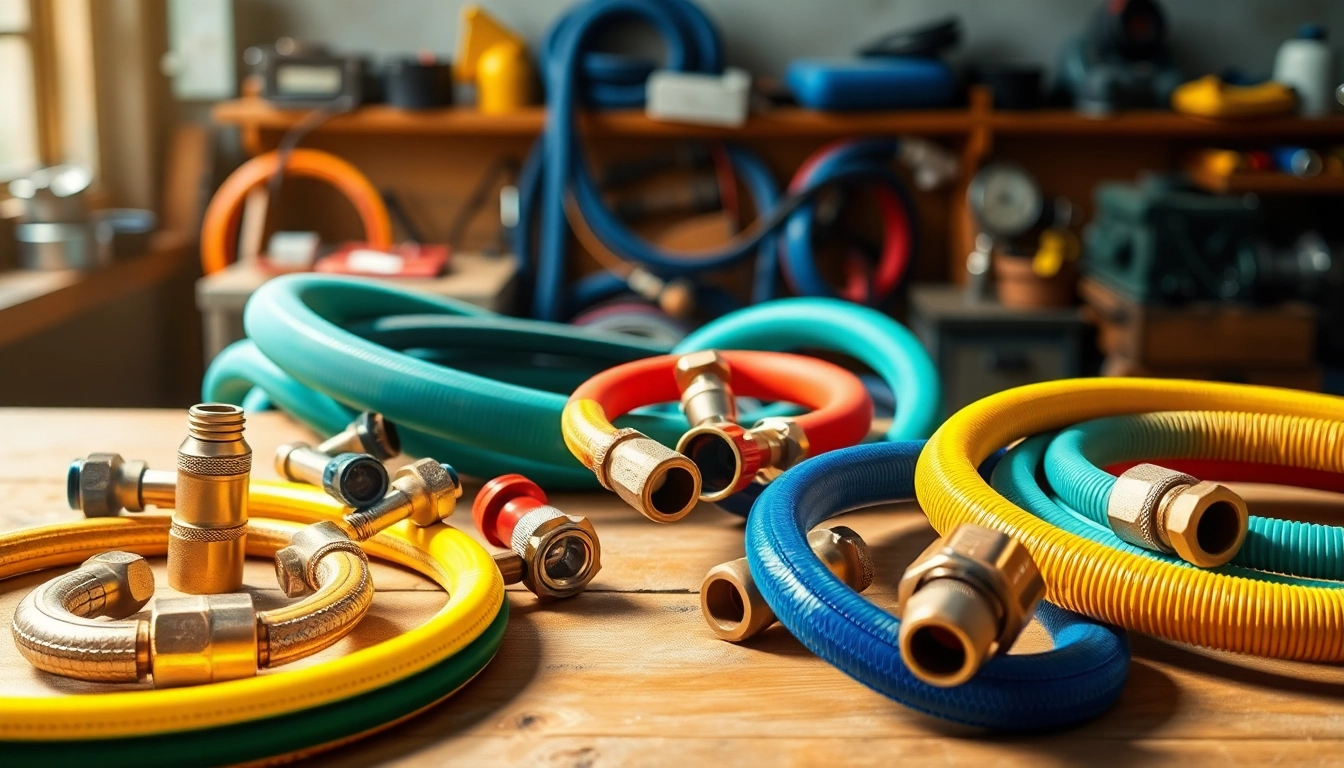
Understanding Air Hoses and Fittings
What Are Air Hoses and Fittings?
Air hoses and fittings are essential components in pneumatic systems that facilitate the transportation of compressed air from an air compressor to various tools and equipment. These components play a critical role in enhancing the performance and efficiency of air-powered tools used in various industries, including automotive, construction, and manufacturing. An air hoses and fittings setup can significantly boost productivity by enabling tools to operate effectively and reliably.
Types of Air Hoses and Their Uses
There are several types of air hoses, each designed for specific applications and environments. Understanding these types is crucial for selecting the right hose for your needs.
- Rubber Air Hoses: Known for their excellent flexibility and durability, rubber hoses can withstand extreme temperatures and are suitable for heavy-duty applications.
- Polyurethane Air Hoses: These hoses are lightweight and provide excellent resistance to abrasion. They are often used in applications where the hose needs to be moved frequently.
- PVC Air Hoses: Made from a blend of polyvinyl chloride, these hoses are generally less expensive and are great for light-duty tasks. However, they may not perform well in colder temperatures.
- Hybrid Air Hoses: Combining the properties of rubber and PVC, hybrid hoses offer flexibility and durability, making them versatile for various applications.
- Coiled Air Hoses: Ideal for areas with limited space, coiled hoses expand when in use and retract when released, promoting easier storage and mobility.
The Importance of Choosing the Right Fittings
Fittings are just as important as hoses; they ensure airtight connections between the hose and tools or compressors. The wrong fittings can lead to air leaks, reduced efficiency, and even safety hazards. It’s crucial to choose compatible fittings that match the hose size and type to prevent these issues. Proper fittings also enable quick connections and disconnections, enhancing workflow and saving time on the job site.
Key Features to Consider When Selecting Air Hoses
Material Types: Rubber vs. Polyurethane
The choice between rubber and polyurethane hoses often comes down to the specific requirements of the task. Rubber hoses are more robust and can handle extreme temperatures, making them suitable for industrial environments. In contrast, polyurethane hoses are lighter and more maneuverable, which can lead to less fatigue during extended use. Depending on your needs, evaluating the pros and cons of each material is essential.
Diameter and Length Considerations
When selecting air hoses, diameter and length are critical factors that can affect airflow and system performance. A hose with a larger diameter can generally carry more volume, which is essential for high-demand applications. Conversely, shorter hoses reduce pressure losses due to distance, making them ideal for quick, short tasks.
Functionality and Compatibility
Ensuring that your air hose is compatible with existing tools and compressors is vital. Check the specifications of your tools and choose hoses that meet or exceed those requirements. Most importantly, consider the maximum working pressure of the hose and make sure it aligns with the tools it will be used with. Proper functionality ensures that your tools work efficiently and safely.
Installation Tips for Air Hoses and Fittings
Step-by-Step Guide to Installing Air Hoses
Installing air hoses and fittings requires attention to detail to ensure that everything is set up correctly. Here’s a step-by-step guide:
- Gather Your Tools: Ensure you have all necessary tools, including the air hose, fittings, tools for cutting the hose, and any additional connectors.
- Measure and Cut the Hose: Measure the required length of hose and cut it carefully to avoid fraying the ends.
- Insert the Fitting: Push one end of the hose over the fitting until it is securely in place. For threaded fittings, ensure you apply the correct amount of thread seal tape to avoid leaks.
- Connect to the Compressor or Tool: Attach the other end of the hose to your air compressor or tool. Ensure a secure fit to prevent air leaks.
- Test for Leaks: Turn on the compressor and check for any leaks by feeling for air escaping around connections.
Common Mistakes to Avoid
When installing air hoses and fittings, common mistakes can lead to improper functioning and safety hazards:
- Using Incompatible Fittings: Ensure that all fittings are compatible with each other; mismatch can lead to leaks.
- Neglecting Hose Length: Too long a hose can result in decreased pressure, while too short can limit mobility.
- Ignoring Maximum Pressure Ratings: Always adhere to the specified pressure limits of both the hose and fittings to prevent failures.
Maintenance Tips for Longevity
Proper maintenance is critical for the longevity and performance of air hoses and fittings. Here are several tips:
- Store Properly: Avoid kinking and damage by coiling hoses carefully and storing them in a cool, dry place.
- Inspect Regularly: Regularly check for signs of wear, leaks, or damage and replace parts as needed.
- Clean Fittings: Ensure fittings are clean and free from debris to ensure optimal connections.
DIY Projects: Maximizing Your Air Hose Setup
Creating Customized Hoses
Creating customized hoses allows users to tailor lengths and fitting configurations to their specific needs. Simply start with a bulk hose and the necessary fittings to create a setup that perfectly fits your workspace or project.
Building Your Air Tool System
Building a comprehensive air tool system involves combining hoses, fittings, and multiple air tools efficiently. Start with the necessary air compressor specifications before adding hoses and tools to ensure you have adequate airflow and pressure for each tool’s requirements.
Safety Practices while Working with Air Tools
When working with air tools, safety should always be a priority. Here are some basic practices:
- Wear Protective Gear: Always wear safety goggles, gloves, and hearing protection when operating air tools.
- Keep Workspace Clear: Ensure that the work area is free from hazards or clutter that could lead to accidents.
- Disconnect When Not in Use: Always disconnect air tools and hoses when not in use to prevent accidental activation.
Where to Buy Quality Air Hoses and Fittings
Top Retailers and Their Offerings
Several retailers are known for their quality air hoses and fittings. Here are some top providers:
- Lowes: Offers a wide variety of air hoses, fittings, and other air compressor accessories.
- The Home Depot: Features a robust selection of air hoses and tools suitable for both DIY and professional use.
- Amazon: Provides a mix of brands and types of air hoses and fittings, often with user reviews and ratings to assist in decision-making.
- Specialized Distributors: Companies like Northern Tool and Factory Direct Hose specialize in tools and accessories for professional settings.
Online Shopping Tips
When purchasing air hoses and fittings online, consider the following tips:
- Check Reviews: Always read user reviews to gauge the reliability and quality of the products.
- Compare Prices: Shop around to ensure you get the best value for your purchases.
- Verify Specifications: Confirm that the specifications match your requirements before purchasing.
Comparing Prices and Quality
Finding the balance between quality and affordability is key when purchasing air hoses and fittings. Compare similar products from various retailers, considering both the price and the customer satisfaction ratings.





